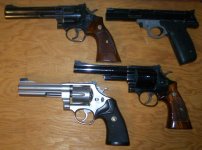No, I wasn't trying to be sarcastic, dave7v7. But I also don't care for wrong information to be posted either. You might be able to help me out with understanding the transfer bar on the Rugers actually as I don't own a Ruger and have never torn one down either. From what I understand of the transfer bar, it actually is interposed between the hammer and firing pin to shoot, right? And if it's not in position, then it also physically blocks the hammer from being able to touch the firing pin. With a Smith, the hammer block does just that and physically blocks the hammer from being able to block either the firing pin (on frame mounted pins) or blocks the hammer nose from being able to drop through the hammer nose bushing and strike the primer with the old style hammers. All this is when the hammer is down. When the hammer is drawn back (single or double action), it is physically removed from blocking the hammer. Also, there is another safety built into the pistol that actually preceded the hammer block. But some time in the 30's I believe, there was some kind of accidental discharge where that block got defeated somehow and a person died and Smith & Wesson came up with the present hammer block they added alongside the older safety mechanism.
As for being against the new guns, well since I just bought a new 60-15 for the wife I can't be too against them. I don't care for the lock they threw in the pistol, but I can live with it so far. As for the MIM parts, that doesn't bother me functionally. Cosmetically, I think the old hammer and trigger look better, but that doesn't change the fact that the MIM hammer and trigger work just fine. And I find that with a lighter rebound spring and a tiny bit of stoning of the rebound slide, that 60-15 has a trigger as nice as any other older S&W I own. It is light and breaks like a glass rod.
As far as my statement on the older hammer mounted firing pins and not being somewhat fragile as compared to the inline frame mounted firing pin, I honestly want to see a link on this. Like I've said, I have a 41 year old 27 that I've owned since 1974 and have seen no evidence of any problems with hammer mounted firing pins personally. But I have read of people having problems with the newer frame mounted pins here on these forums with dry firing. Not a lot of them, but I have read of it. That 27 has had over 30k rounds through it and who knows how many times I've dry fired it. And the only problem I had was with the hammer catching on the trigger in single action with the original hammer and trigger. I guess something wore enough for that to start happening and I just replaced both hammer and trigger that came with my pistol with the wider target models. I still have the original hammer nose bushing in it and it is still in decent shape except for a couple of surface pits in it from some way overpressured PMC ammo I bought back in the 70's or 80's when I first saw PMC ammo for sale. It was so overpressured that it was piercing the primers and you had to put something between your palm and the ejector rod to get the cases out without hurting your hand.
Don't go off mad; we are all here to help each other out on these forums. Hopefully my explanations (poor as they are, I'm no gunsmith) help you to understand a Smith out better and maybe I can learn some things from you. Heck, I'm 59 years old and I still get a kick out of learning new facts and information.
Be cool!
mudd
PS: dey59, sorry for hijacking your thread a bit man. I hope you understand.



